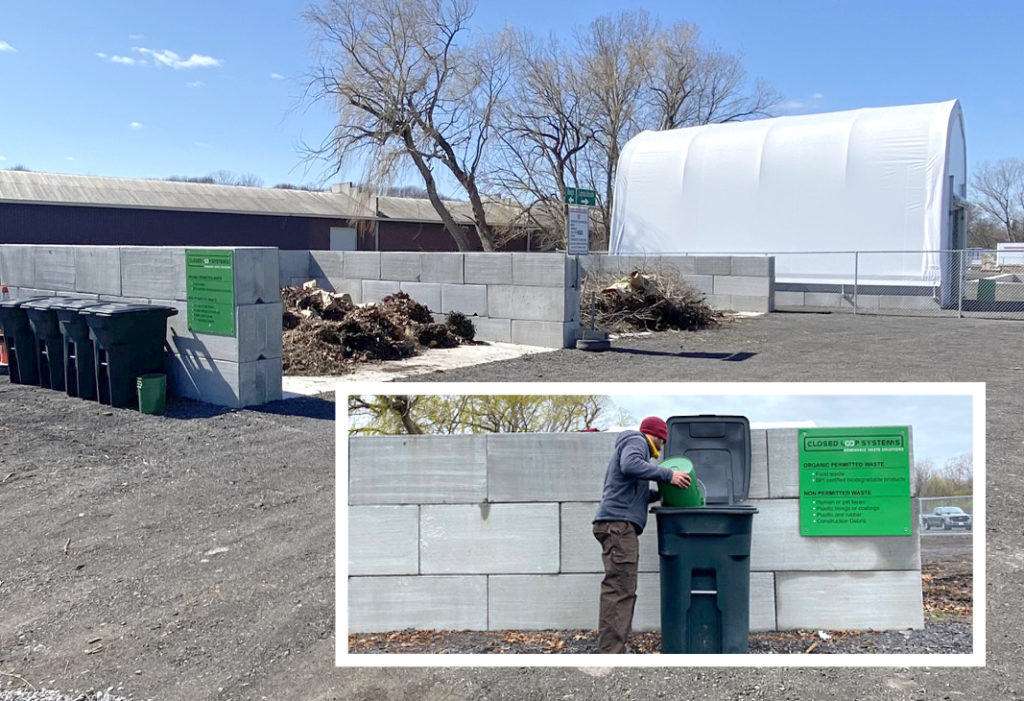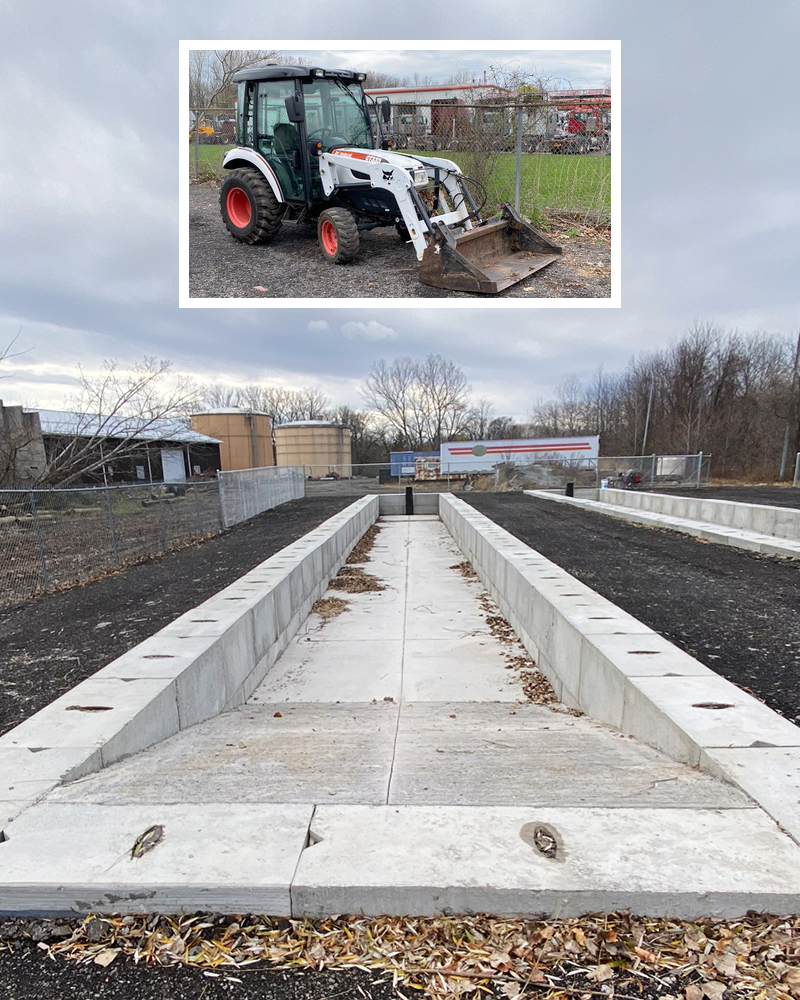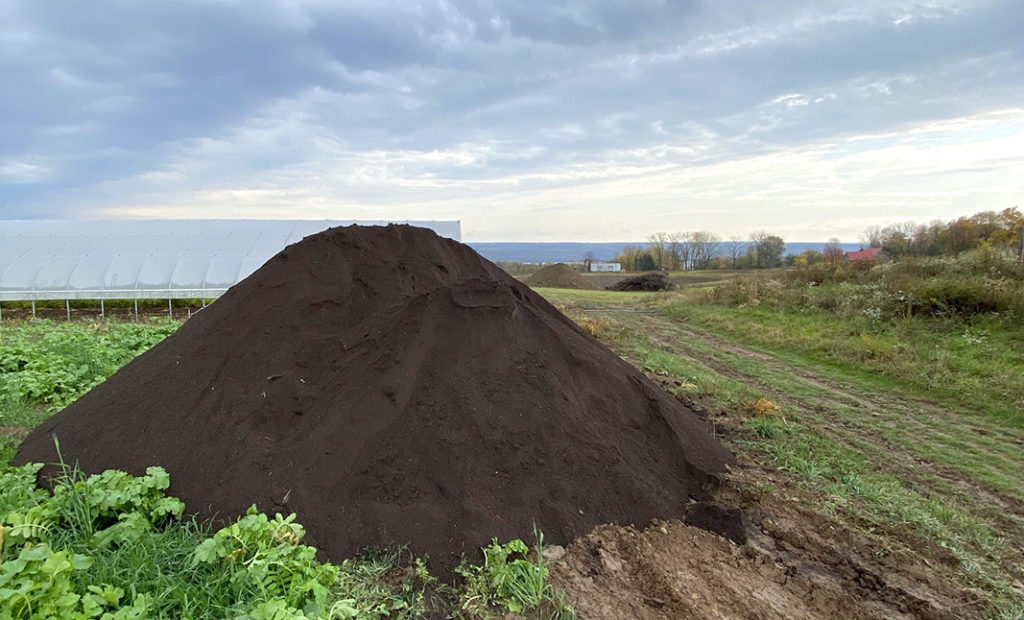Top: Feedstocks are mixed and precomposted in passively aerated static piles inside the fabric structure.
Nora Goldstein
Jacob Fox of Geneva, New York, cut his vermicomposting teeth at a large farm-based facility in the Finger Lakes region of the state. “I recognized the ability that vermicomposting had in handling large amounts of biodegradable waste,” explains Fox. “We successfully processed source separated food scraps from schools and events, as well as ground yard trimmings and certified compostable packaging. The company running the facility was essentially in the soils business, not waste management, and I saw an opportunity to build on this closed loop process with other waste streams.”
In 2020, Fox partnered with Nardozzi Paving & Construction, a Geneva-based construction company, to start Closed Loop Systems (CLS), a waste management company that designs, builds, operates, and maintains “customized resource recovery facilities” to implement “renewable waste solutions that serve a circular economy,” according to the website. James Nardozzi and Michael Nardozzi serve as CLS’ President and Vice-President, respectively. Fox is the CEO. The company’s first project, which opened in March 2021, is the Geneva Resource Recovery Park (GRRP). The Park features a vermicomposting facility designed to process 2,500 tons/year of source separated organics and 2,500 tons/year of yard trimmings. CLS operates the site under a New York State Department of Environmental Conservation registration status.
The 1-acre site is leased from the City of Geneva. In addition to the on-site organics recycling operation, it will soon be servicing residents as a residential drop-off and transfer station for recyclables and trash. “We will have other recyclers’ bins at our site to collect metal, construction and demolition debris, bottles and cans, etc.,” says Fox. “The materials will be aggregated and sent to those companies’ recycling facilities. Trash collection will be contracted with a local company. The drop-off facility is only open to residents of the town and city of Geneva, which are adjacent to each other.”
Launching With Organics
Closed Loop Systems’ (CLS) organics recycling facility at the GRRP has drop-off carts for residential food scraps, and an area for yard trimmings, including leaves, grass and brush. The city of Geneva has operated a yard trimming drop-off site for many years. The GRRP is coordinating with the city as follows: larger items (limbs, brush) dropped at its facility will be taken to the city’s site for grinding; leaves dropped off at the city’s site will be brought to the GRRP for composting. Residents of Geneva (City and Town) purchase a “Green Tag” organics disposal permit from CLS for $15/year to drop off food scraps; yard trimmings are dropped off for free. Permits also will be sold for dropping off trash and recyclables.

The organics drop-off area at the Geneva Resource Recovery Park includes carts for household food scraps (left and inset) and areas for leaves (center) and brush (far right). Trucks tipping food waste unload in the fabric building.
The drop-off hours are 9:00 AM-5:00 PM on Wednesday and Saturdays. In addition to all food scraps, residents can include food-soiled paper, paper plates and takeout containers (not wax or plastic coated), soiled pizza boxes and BPI certified biodegradable products. Food scraps in BPI-certified compostable liner bags are accepted. “We sell the Green Tag permits and use the revenue to run the facility,” explains Fox. “We plan to get 5,000 households in the city and town of Geneva to participate. We will be expanding to a full drop-off and transfer station for recycling and garbage shortly.”
CLS started a food scraps pick up service to accommodate larger generators. It provides 32- and 64-gallon carts for smaller locations, and 120-gallon toters for a large food processor in town. The collection truck unloads in a fabric building at the GRRP that is 20-feet wide by 40-feet long by 20-feet tall. The building also houses the precomposting process — essentially passively aerated piles that use PVC pipes and larger sticks and branches to facilitate air flow. Yard trimmings are mixed with food scraps and other separated organics using a loader bucket. “We precompost in the building until we have about 100 cubic yards of material,” explains Fox.
Vermicomposting Trenches

The engineered vermicomposting trenches each have 200 cubic yards of capacity. A tractor with loader attachments (inset) is used to fill and empty the trenches. Photos courtesy of Closed Loop Systems
The facility has two concrete, engineered vermicomposting trenches that are 6-feet deep, 12-feet wide and 100-feet long. Each trench can hold 200 cubic yards (cy) of material. “We will be putting our first batch in a trench very soon as we almost have 100 cy of precomposted material,” he adds. “We will add 50 pounds of inoculant that includes red wiggler and nightcrawler worms as well as other microbes in the ‘Soil Food Web.’ Moisture is maintained in the 60% to 70% range. Fresh vegetative food scraps such as lettuce can be added on top of the filled trench, but feedstocks like meat and dairy products, and compostable bags have to be precomposted.”
The trenches are lined with a heavy-duty construction liner and drain to a tank to collect leachate and rainwater. The liquid is recycled back on to the vermicomposting beds. Material is expected to stay in the trenches for about 6 months to maximize the biological diversity of the finished product. CLS has a tractor that is sized to work inside the trench, e.g., fill the trench with precomposted material and remove finished compost. The tractor has several different bucket attachments along with an excavator attachment. The facility is designed to operate year-round as the 6-foot deep trenches are warmed naturally with geothermal heat.
“The system is operated on a batch process, so fresh material is added, and the worms migrate from finished material to the fresh batch,” says Fox. “We also will run the vermicompost through a one-eighth-inch screen to remove any contaminants, and put worms still in the material after screening back into the trench.”
Green Tag holders are eligible for CLS’ community soil giveback program, where quarterly, citizens can take home up to 20 lbs of soil made at the GRRP, for free. The company also will sell the product in bulk, along with vermicompost tea. “We will be continually expanding our retail offerings as soil blends, liquids and other products become available,” he adds.














